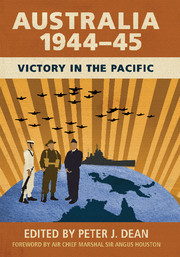Book contents
- Frontmatter
- Dedication
- Foreword
- Contents
- Maps and chart
- Figures and table
- Contributors
- Acknowledgements
- Abbreviations
- Military symbols on maps
- Introduction
- PART 1 STRATEGY
- PART 2 AUSTRALIA AT WAR
- PART 3 GREEN ARMOUR AND SPECIAL OPERATIONS
- PART 4 THE NAVAL AND AIR WAR
- PART 5 THE NEW GUINEA CAMPAIGN
- 10 ‘Given a second rate job’: Campaigns in Aitape-Wewak and New Britain, 1944–45
- 11 More Than Mopping Up: Bougainville
- PART 6 THE BORNEO CAMPAIGN
- Afterword: And Then Came Peace?
- Index
- References
11 - More Than Mopping Up: Bougainville
from PART 5 - THE NEW GUINEA CAMPAIGN
Published online by Cambridge University Press: 05 December 2015
- Frontmatter
- Dedication
- Foreword
- Contents
- Maps and chart
- Figures and table
- Contributors
- Acknowledgements
- Abbreviations
- Military symbols on maps
- Introduction
- PART 1 STRATEGY
- PART 2 AUSTRALIA AT WAR
- PART 3 GREEN ARMOUR AND SPECIAL OPERATIONS
- PART 4 THE NAVAL AND AIR WAR
- PART 5 THE NEW GUINEA CAMPAIGN
- 10 ‘Given a second rate job’: Campaigns in Aitape-Wewak and New Britain, 1944–45
- 11 More Than Mopping Up: Bougainville
- PART 6 THE BORNEO CAMPAIGN
- Afterword: And Then Came Peace?
- Index
- References
Summary
Bougainville was one of the largest campaigns fought by Australians during the Second World War. More than 30,000 Australians served on the island, over 500 were killed and two Victoria Crosses were awarded. By 1945, Australia had been marginalised from the key battles that would defeat Japan, relegated instead to bypassed areas in Australia's Mandated Territory of New Guinea and Bougainville, and on Borneo. The necessity of these campaigns was debated in parliament while the press echoed such criticisms. Soldiers too had their own opinions. Brigadier Heathcoat ‘Tack’ Hammer, who commanded an infantry battalion at El Alamein and an infantry brigade on Bougainville, later commented: ‘everyman knew, as well as I knew, that the Operations were mopping up and that they were not vital to the winning of the war’. As this author has argued elsewhere, Bougainville was a necessary campaign. It fulfilled the Australian government's long-stated policies of maintaining an active military effort and employing Australian forces in Australian territory, and was conceived when the war was expected to continue until at least 1946.
Commanded by Lieutenant General Stanley Savige, the Australian operations on Bougainville were initiated in order to shorten the campaign in the Mandated Territories, with the ultimate goal of freeing up manpower. The alternative was to statically garrison the island indefinitely. Crucially, the campaign was initiated when the Australians mistakenly believed they outnumbered the Japanese. A Great War veteran, Savige had commanded a brigade in North Africa in 1941 and a division in New Guinea in 1943. A strong supporter of General Sir Thomas Blamey, Savige was no stranger to controversy.
Savige tightly controlled the campaign. He divided the island into three areas: the Central, Northern and Southern Sectors. In the Central Sector, the Australians crossed the Numa Numa trail over the island's mountainous spine. This was the ‘nursery sector’ where units gained combat experience before being deployed to more active areas. In the Northern Sector, the Australians followed the northwest coast towards Buka. The advance went well until a small force made a disastrous landing at Porton Plantation in June 1945. It was the only Australian defeat of the campaign. The main fight, however, was in the Southern Sector where the Australians advanced towards Buin, the major Japanese base on the island.
- Type
- Chapter
- Information
- Australia 1944–45Victory in the Pacific, pp. 232 - 252Publisher: Cambridge University PressPrint publication year: 2015



